Norway
-
- From Norway to Brazil (and Back) Maritime Logistics Professional, Q2 2013 #48
Norway’s involvement with this South American energy powerhouse predates the current oil boom. Today’s commerce model flows in both directions in ever increasing frequency and volumes.
Make no mistake about it: Brazil is important to Norway. So important that the Norwegian government’s strategy for developing additional business here includes broad reaching initiatives such as Innovation Norway (IN), providing advisory and networking services for Norwegian companies in Rio de Janeiro, INTSOK (Norwegian Oil and Gas Partners – offering a range of services to the oil and gas industry in close cooperation with Innovation Norway), The Norwegian Seafood Export Council (marketing Norwegian seafood industry in Brazil) and branches of the Norwegian–Brazilian chambers of commerce in Rio de Janeiro, São Paulo and Oslo. Additionally, The Norwegian Embassy, the Consulate General in Rio de Janeiro (co-located and cooperates closely with Innovation Norway, INTSOK and the Seafood Export Council) also play an important coordinating role.
Global energy heavyweights Brazil and Norway have been doing business for decades. Over time, Norwegian firms of all sizes have established and maintained a physical presence in Brazil. The ongoing oil boom in Brazil has only solidified these ties and Norway’s recognized leadership in oil & gas technology have been well received locally and put to good work in the southern Hemisphere. Trade between the two nations has increased sharply – almost 300 percent increase – in the last decade alone.
In the beginning, the most visible ties between these seemingly different and geographically separated countries included primarily the cod and newsprint trades. That’s anything but the case, now.
Weighing in on all of that last month was the Norwegian Consul for Commercial Affairs in Rio de Janeiro, Helle Moen and Henrique Schlaepfer, Area Director for Latin America, Wilhelmsen Ships Service. Moen told MarPro in April, “The size of the Brazilian market, the country’s diversified economy and the growth of its middle class offer opportunities for a broad range of Norwegian companies.” She added, “the Norwegian petroleum and maritime sector is already strongly represented here. And, Brazil is one of Norway’s most important export markets and one of the most important recipients of Norwegian investments.”
It turns out that doing business in Brazil has its rewards. Those rewards do not come without challenge – or risk.
Norway: Right at Home in Brazil
It isn’t so much a story of what Norway can bring to Brazil as much as it is a list of who is already here. And that list is a veritable “who’s-who” of over 150 Norwegian companies, 95% of whom are related to the oil & gas and shipping business. The major players with a significant local presence include, among others, Statoil, Kongsberg, Aker Solutions, Farstad, Solstad along with a raft of Norwegian financial institutions. That said, Helle Moen insists, “The majority of the companies established here are small and medium sized companies.”
Wilhelmsen Ship Service is one such Norwegian company, providing a wide range of products and services to the maritime industry. Wilhelmsen Ship Service do Brasil today operates from 40 service locations, catering to ships and rigs all along the Brazilian coastline. Henrique Schlaepfer told MarPro in April, “We have been in Brazil for a long time. There is no doubt that we have experienced tremendous growth here; in the last 3 years alone our sales in Brazil have doubled.”
Schlaepfer says that the potential for even greater growth is still very real. The advent of the energy era in Brazil has more than tripled in the number of Norwegian firms on Brazilian soil in the last decade alone. And, because Norway has always been a leader in exporting technology and expertise to the global oil patch, their presence in the world’s fastest growing offshore market is a natural, convenient and easy fit.
Away from the Coast, Close to the Heart
Leveraging its rich hydropower resources, Norway has long been Europe’s largest aluminum producer. This involved early cooperation with Brazilian companies to ensure the availability of raw materials. To that end, Norway-based Hydro and the Brazil bulk commodity heavyweight Vale concluded an agreement in 2011 that will benefit both players into the foreseeable future.
In the area of renewable energy, Norway is already in close dialogue with Brazil to promote hydropower and other forms of renewable energy. As Brazil ramps up its nascent hydropower development program, Norway’s expertise and financial help will likely be a big part of that, as well as some local bioethanol projects. And, consistent with all of that, Norway is also known for its attention to environmental legislation and standards, and is keen to help these industries develop in as clean and environmentally sensitive manner. Indeed, Environmental issues are high on the political agendas of both countries, and Brazil today finds itself at the forefront of efforts to reduce deforestation, holds a leading position in biofuel production and is a key player in global processes concerned with the environment and sustainable development. As their industrial relationship increases, both nations are cooperating to provide for sustainable development. Moen adds, “Norway wishes to be an active and constructive cooperation partner in these efforts. Norway supports Brazil’s efforts to reduce emissions from deforestation and forest degradation through its contribution to the Amazon Fund. Even before the establishment of the Fund, Norway had a long history of support for Brazilian indigenous people’s organizations both in and outside the Amazon region.”
Balancing Opportunity with Risk
According to Norway’s Helle Moen, “Brazil offers many opportunities for Norwegian companies, but they also need to take active steps in to deal with local challenges. For example, Companies tend to find the Brazilian legislation and taxation system complex.” Beyond this, intense competition for qualified local labor is fueled by local content requirements that companies must respect. Moen adds, “IN aims to make Norwegian companies competitive in international markets. We support the business development of Norwegian industry through financing, competence development training, temporary office facilities in Rio, market analysis, partner search and business development plans.” In short, IN’s main goal is to contribute to the increase the success rate of the Norwegian companies in foreign markets, Brazil in particular.
Henrique Schlaepfer, Area Director for Latin America, Wilhelmsen Ships Service is candid about what it takes to make it here. He explained, “Major challenges include the bureaucracy and protectionist policies.” For example, he said, and because of local taxes and regulations, foreign manufactured products can be up to four times as expensive as products manufactured in Brazil. Schlaepfer insists that he can compete, however. “Our answer is to focus on our network, our proven quality and our ability to deliver at the right time at the right price.”
On the subject of bureaucracy, he pointed to the large number of governmental agencies that add to an already difficult documentation process for foreign companies doing business here. That said, Henrique also reported that the Brazilian government was taking strides to improve its performance, digitalizing documentation, decreasing the amount of documents required and engendering a mentality of efficiency into government service. Wilhelmsen’s efforts to engage an efficient workforce have also presented problems – training and education in particular – even as they try to employ a more local staffing policy here. For this reason, WSS actually certifies even local staff from Wilhelmsen Headquarters in Norway, in order to maintain their standards.
As Brazil struggles with the long term debate over of how best to distribute the vast financial benefits of the oil and gas boom to society, Norway watches with interest, but largely from the sidelines. According to Moen, Norway’s fund was established to ensure that tomorrow’s generations benefit from today’s oil wealth. For example, the Norwegian Government Pension Fund Global (GPFG) was structured to safeguard economic stability for both the long and short term, with the intent of ensuring that revenues from the petroleum sector are gradually phased into the Norwegian economy from the GPFG to a level that can be sustained. But Moen also says, “Nevertheless, Norway does not intend to interfere in internal questions of Brazil.” That said, the Norwegian Fund held $5.9 billion worth of equities in 98 different companies, and $732 million of bonds from seven bond issuers in Brazil.
Commerce: a two-way street
Longstanding commercial ties that bind both nations move in both directions. Starting with the dried codfish and coffee trades in the 1800’s, Norway’s imported goods from Brazil have always been important. These came to USD $1.4 billion USD in 2012, an increase of 11% from 2011. And Brazilian companies – notably Vale’s 2011 investment in Norsk Hydro (via Norsk Hydro ASA’s acquisition of Vale’s aluminium activities) – are significant investors in Norwegian enterprises. Today, Vale’s 22 percent ownership in Norsk Hydro makes Vale the second largest shareholder in Norsk Hydro after the Norwegian state.Preparing for tomorrow - Together
Consistent with its far reaching plans for offshore oil development, Brazil is actively building a fleet of offshore service vessels (OSV) to service those needs. The considerable backlog of Brazilian shipyards – 367 vessels, of which about 70 are OSV’s – includes a clear effort to build at home to service local requirements. It also incorporates a vast amount of technology, knowhow and equipment from other places. No one country is more involved in that effort than is Norway.
As a leading manufacturer and operator of OSVs, Norway has always been closely linked with this fast growing market; here, in the U.S. Gulf of Mexico and other markets, too. That’s because as Norway’s oil & gas industry grew up in the rough weather of the North Sea, so too did the need for tough, well-crafted and comfortable vessels. Many innovations, therefore, emanating from Norway - architectural design, dynamic positioning, eco-friendly, dual fuel propulsion systems, cranes and world-renowned crew accommodations are coming to the offshore Brazil markets.
As many as nine local shipyards, accounting for more than USD $4 billion in investments, affirms UNCTAD’s 2012 data that Brazil’s shipbuilding program is one world’s largest, especially as compared to the size of its own fleet. Much of that is being accomplished through joint ventures with others. And, the latest Petrobras business plan (2013-2017) – Brazil’s major local oil and gas firm – predicts and plans for substantial growth in that sector. That leaves plenty of room for more growth in trade between Norway and Brazil.
Uncommon Bonds – Critical Ties
Arguably, and in the global arena, there may be no two more dissimilar nations with more in the way of economic ties today than Brazil and Norway. Nevertheless, from the North Sea all the way to the Southern Atlantic Ocean, commerce flows in both directions, in the form of trade, technology and a common desire to improve both bottom lines. From the Brazilian side of the equation, the growing pains that impact business are slowing being sorted out. Separately, Norway’s government continues to invest heavily in terms of time and money to make sure that the relationship(s) continue to flourish. Very much a work in progress, it is an imperfect relationship, one with deep historical roots, and staying power that is likely to grow even stronger.(As published in the 2Q edition of Maritime Professional - www.maritimeprofessional.com)
-
- Chemical Tanker Turned OSV Maritime Reporter, Jan 2015 #26
.” Yet, both he and his chairman tell us the goal is “to operate like other OSVs.” The market is the huge new Barents Sea arctic oil province north of Norway as well as East Africa’s giant, untapped Rovuma Basin off Tanzania and Mozambique. Compatriot oil company Statoil — a giant local contact and charterer
-
- Kongsberg EVOTEC: All about A-Frames Marine Technology, Dec 2014 #42
Making ships gear can require deep pockets. Ask Kongsberg Evotec AS management. A savage turn of fortunes for offshore surveyors has cooled orders for handling machinery from seismic vessel owners. As much as 80 percent of the survey business has, in places, evaporated and left widespread disbelief. To
-
- MTR100: The Norway Way Marine Technology, Jul 2014 #50
Norway has a long and rich seafaring history, and it also sits on one of the world’s richest oil & gas resources in its sector of the North Sea. Earlier this year MTR contributor Eric Haun traversed the country in search of companies worthy inclusion in this year’s MTR100. He found, and presents here
-
- Esso Norway Test Of Hull Structure Proves Design And Good Workmanship Maritime Reporter, Feb 1974 #14
From June 28 to July 7, 1969, the new 190,- 800-dwt tanker Esso Norway lay at anchor in Eckernfoerde Bay, about 20 miles from Kiel, Germany, where she was built. Figure 1 gives the general arrangement and dimensions of this ship. An extensive static structural test program was carried out on a
-
- Norway's Caretaker Protects Precious Cargo Maritime Reporter, May 2001 #50
computerized evacuation and survival system — specifically geared toward the Hospitality and Lodging industry. Already installed in two hotels in Oslo, Norway, Caretaker is striving to find its niche within the cruise industry. In fact, the company displayed its system at this year's SeaTrade Cruise Shipping
-
- Norwegian Line Unable to Remedy Leaky Sprinklers on the Norway Maritime Reporter, Jun 2001 #98
Norwegian Cruise Line canceled the weekly sailing of its ship Norway on May 29 because of leaks in the fire sprinkler system, thwarting Caribbean vacation plans for more than 2,000 passengers stuck in Miami. The Norway had been scheduled to leave the Port of Miami on May 27 for a seven-day cruise to
-
- SS Norway Boiler Room Explosion Claims Seven Lives Maritime Reporter, Jun 2003 #3
On the morning of Sunday, May 25, 2003, passengers onboard the Norwegian Cruise Lines' (NCL) vessel, S/S Norway awoke to a loud boom, as the vessel returned from seven-day Caribbean cruise to its homeport in Miami, Fla. The noise, which came from the vessel's engine room, is believed to be caused by
-
- First Of Four Parcel Tankers Being Built For Stolt Named At Kleven Floro Yard In Norway Maritime Reporter, Jan 1991 #11
tankers being built for Stolt Tankers and Terminals (Holdings) S.A., was recently named at the Kleven Floro A/S shipbuilding yard at Floro, Norway. Mrs. Mary Wright, wife of Christopher J. Wright, president of Stolt-Nielsen, was godmother. The deliveries of the M/T Stolt Helluland and her
-
- Norway Export Award Goes To Peter Lombard Maritime Reporter, Dec 1990 #7
Peter P. Lombard, president of American United Marine Corporation, has been honored for his outstanding contribution to trade relations with Norway and the United States and has been awarded a special export diploma by the Export Council of Norway. The award, first given in Copenhagen in 1966
-
- NOR-FISHING '86 Trondheim, Norway, August 11-16 Maritime Reporter, Aug 1986 #8
Nor-Fishing '86, the 11th International Fishery Fair to be held in Trondheim, Norway, August 11-16, has been fully booked, with the Nidaro Exhibition Hall filled to its maximum capacity, despite a space increase of 30 percent over 1984. Thus, this year's Nor-Fishing exhibition will be the biggest
-
- Tenneco Announces A Significant Oil Discovery Off Norway Maritime Reporter, Oct 15, 1985 #4
Tenneco Oil Exploration and Production recently announced a significant oil discovery offshore Norway on Haltenbank Block 6507/7, the second major hydrocarbon discovery this year on the block, in which the company is a partner. The 6507/7-3 well flowed at a combined daily rate of 15,491 barrels of
-
 )
March 2024 - Marine Technology Reporter page: 45
)
March 2024 - Marine Technology Reporter page: 45(USP). Cumu- latively these are milestones in Greensea IQ’s continuous global expansion efforts, and Greensea IQ’s footprint will now encompass Finland, Norway, Sweden, and Spain. The new business relationships will see BUVI and USP represent Greensea IQ and its complete range of Bayonet autonomous underwater
-
 )
March 2024 - Marine Technology Reporter page: 33
)
March 2024 - Marine Technology Reporter page: 33to form, so biodiversity loss would essentially be permanent. And in Feb- ruary 2024, the European Parliament passed a resolution raising concerns about Norway’s mining intentions. www.marinetechnologynews.com 33 MTR #3 (18-33).indd 33 4/4/2024 9:17:27 A
-
 )
March 2024 - Marine Technology Reporter page: 29
)
March 2024 - Marine Technology Reporter page: 29n January, Norway said “yes” to sea- bed mining, adding its weight to the momentum that is likely to override the calls for a moratorium by over 20 countries and companies such as I Google, BMW, Volvo and Samsung. Those against mining aim to protect the unique and largely unknown ecology of the sea?
-
 )
April 2024 - Maritime Reporter and Engineering News page: 39
)
April 2024 - Maritime Reporter and Engineering News page: 39.lego.com/ etc., but also eliminates the need for scaffolding, projects/1de118e0-b9bc-4177-9b58-efd33bf4e2f5 reducing labor costs and scaffolding costs. Norway OKs Ammonia Bunkering Terminal The Norwegian Directorate for Civil Protection gave its ap- shore supply vessels that regularly call at Fjord Base in
-
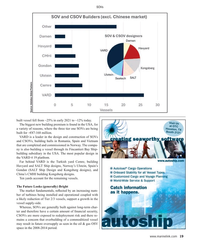 )
April 2024 - Maritime Reporter and Engineering News page: 19
)
April 2024 - Maritime Reporter and Engineering News page: 19. VARD is a leader in the design and construction of SOVs and CSOVs, building hulls in Romania, Spain and Vietnam that are completed and commissioned in Norway. The compa- ny is also building a vessel through its Fincantieri Bay Ship- building subsidiary in the USA. The most popular design in the VARD 4 19
-
 )
January 2024 - Maritime Reporter and Engineering News page: 40
)
January 2024 - Maritime Reporter and Engineering News page: 40will be operational by beginning of 2027. both shallow and deep water for power generation in ? oating The vessel is designed by Vard Design in Ålesund, Norway. offshore wind farms and for direct current power transmission The hull will be built at Vard Shipyards Romania in Tulcea, projects. It will also
-
 )
November 2023 - Marine News page: 47
)
November 2023 - Marine News page: 47Americas, said, “The Green Diamond of power, or, if needed, onboard Caterpillar C18 generators. demonstrates how industry can collaborate to make strides Norway-based Corvus Energy earlier this year opened towards pro? table decarbonization in the shipping sector. a new factory Bellingham, Wash. in response
-
 )
November 2023 - Maritime Reporter and Engineering News page: 8
)
November 2023 - Maritime Reporter and Engineering News page: 8Offshore Services 1,254.7 69 Bram OTM 705.9 33 Tidewater Offshore Operations 689.7 49 (By Country) United States of America 8,386.2 894 Norway 3,319.1 216 Brazil 3,257.6 248 Singapore 2,754.9 483 China 2,571.0 450 Top OSV Buying Companies (Spend) Buyer Company Spend ($) # Vessels Tidewater
-
 )
September 2023 - Marine Technology Reporter page: 64
)
September 2023 - Marine Technology Reporter page: 64International and Control Center. Subsea7 also has two onshore control centers Chevron. “By automating the inspection process with this in Stavanger, Norway. state-of-the art robotic technology, we can dramatically reduce the cost and risk of these important subsea inspections which University of Houston
-
 )
September 2023 - Marine Technology Reporter page: 30
)
September 2023 - Marine Technology Reporter page: 30and bathymetry, used to faster than ever before. Recently launched with ocean sci- detect small objects right down to 6000 meters. ence customers in Norway and Europe, Blue Insight is now One of the most important developments of recent years available globally across all market segments. 30 September/Octob
-
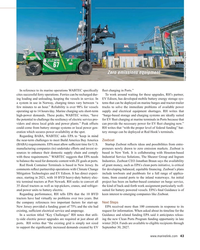 )
September 2023 - Maritime Reporter and Engineering News page: 43
)
September 2023 - Maritime Reporter and Engineering News page: 43partner, ing loading and unloading, keeping the vessels in service. In EV Edison, has developed mobile battery energy storage sys- a system in use in Norway, charging times vary between “a tems that can be deployed on marine barges and tractor-trailer few minutes to an hour.” Reliability is over 98% for
-
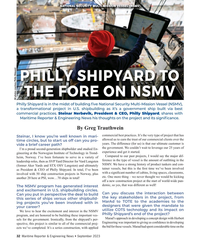 )
September 2023 - Maritime Reporter and Engineering News page: 32
)
September 2023 - Maritime Reporter and Engineering News page: 32and get it started. gineering at the Norwegian Institute of Technology in Trond- Compared to our past projects, I would say the major dif- heim, Norway. I’ve been fortunate to serve in a variety of ference in the type of vessel is the amount of out? tting in the leadership roles, then as SVP Yard
-
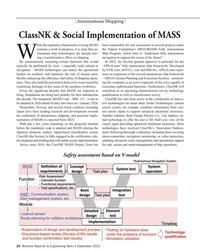 )
September 2023 - Maritime Reporter and Engineering News page: 22
)
September 2023 - Maritime Reporter and Engineering News page: 22of innova- be adopted in 2026 ahead of entry into force on 1 January 2028. tive technologies for smart ships. Groke Technologies’ camera Meanwhile, Norway and several Asian countries including sensor system, for example, combines information from vari- Japan have been leading research and development
-
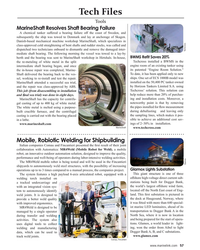 )
August 2023 - Maritime Reporter and Engineering News page: 57
)
August 2023 - Maritime Reporter and Engineering News page: 57North East coast of Eng- tem to autonomously identify land. This ? rst substation is pictured in weld joints. It is designed to the dock at Haugesund, Norway, where provide a better weld quality it was ? tted with more than 640 special- with improved ergonomics. ist marine LED luminaires, ahead of its
-
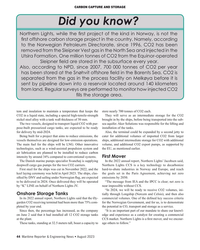 )
August 2023 - Maritime Reporter and Engineering News page: 44
)
August 2023 - Maritime Reporter and Engineering News page: 44CARBON CAPTURE AND STORAGE Did you know? Northern Lights, while the ? rst project of the kind in Norway, is not the ? rst offshore carbon storage project in the country. Namely, according to the Norwegian Petroleum Directorate, since 1996, CO2 has been removed from the Sleipner Vest gas in the North Sea
-
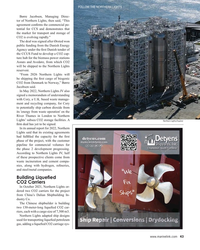 )
August 2023 - Maritime Reporter and Engineering News page: 43
)
August 2023 - Maritime Reporter and Engineering News page: 43CO2 will be shipped to the Northern Lights reservoir. “From 2026 Northern Lights will be shipping the ? rst cargo of biogenic CO2 from Denmark to Norway,” Børre Jacobsen said. In May 2022, Northern Lights JV also signed a memorandum of understanding with Cory, a U.K. based waste manage- ment and
-
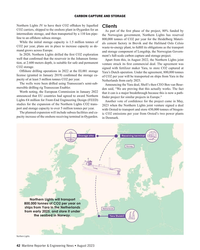 )
August 2023 - Maritime Reporter and Engineering News page: 42
)
August 2023 - Maritime Reporter and Engineering News page: 42. Northern Lights will transport 800,000 tonnes of CO2 per year on ships from Yara in the Netherlands from early 2025, and store it under the seabed in Norway. Northern Lights 42 Maritime Reporter & Engineering News • August 2023 MR #8 (34-49).indd 42 8/3/2023 9:37:03 A
-
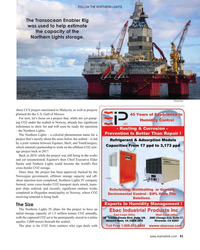 )
August 2023 - Maritime Reporter and Engineering News page: 41
)
August 2023 - Maritime Reporter and Engineering News page: 41Malaysia, as well as projects planned for the U.S. Gulf of Mexico. For now, let’s focus on a project that, while not yet pump- ing CO2 under the seabed in Norway, already has signi? cant milestones to show for and will soon be ready for operation – the Northern Lights. The Northern Lights – a celestial phenomenon
-
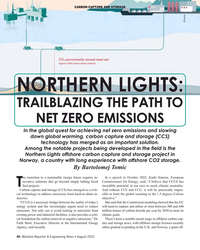 )
August 2023 - Maritime Reporter and Engineering News page: 40
)
August 2023 - Maritime Reporter and Engineering News page: 40as an important solution. Among the notable projects being developed in the ? eld is the Northern Lights offshore carbon capture and storage project in Norway, a country with long experience with offshore CO2 storage. By Bartolomej Tomic he transition to a sustainable energy future requires in- In a speech
-
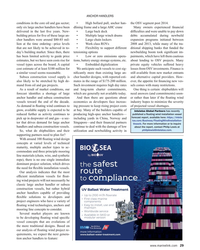 )
August 2023 - Maritime Reporter and Engineering News page: 29
)
August 2023 - Maritime Reporter and Engineering News page: 29to producing high-spec anchor handlers— forecast report, available here: https://intela- pick up in deepwater oil and gas—a sec- including yards in China, Norway and tus.com/Business/FloatingWindInstallation- tor that drives demand for large anchor Singapore—and their ? nancial partners Vessels. For more
-
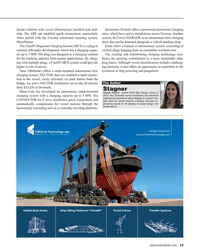 )
August 2023 - Maritime Reporter and Engineering News page: 19
)
August 2023 - Maritime Reporter and Engineering News page: 19offers autonomous horizontal charging ship. The APS can establish quick connections, particularly arms, which have active installations across Norway. Another when paired with the Cavotec automated mooring system, system, the FerryCHARGER, is an autonomous bow charging MoorMaster. davit that can
-
 )
August 2023 - Maritime Reporter and Engineering News page: 18
)
August 2023 - Maritime Reporter and Engineering News page: 18is one challenge to consider that is an autonomous solution for bow charging, which has instal- impacts the safety and speed of connection. lations across Norway. Another system with existing active Most existing RCS utilize positive restraint mooring, typi- installations is the APS tower, a semi-autonomous
-
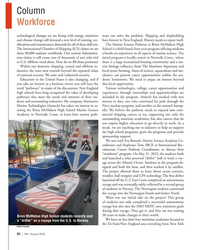 )
August 2023 - Marine News page: 20
)
August 2023 - Marine News page: 20. The ? rst drifter launched off the U.S. East Coast completed an autonomous voyage and was eventually safely collected by a second group of students in Norway. The Norwegian students continued the voyage into the Norwegian Fiords and farther North. What was our initial take on the project? This group of
-
 )
June 2023 - Maritime Reporter and Engineering News page: 31
)
June 2023 - Maritime Reporter and Engineering News page: 31schemes. 3) At a national level, and of importance to ? oating marine segment can be found at global, regional, national and wind, we note for example Norway’s support of partial or full local levels: electri? cation of vessels or the use of hydrogen and ammonia 1) At a global level, International Maritime
